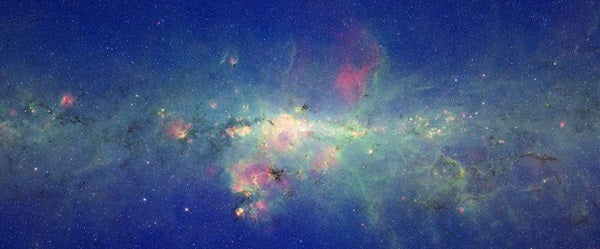To create the image, Spitzer scientists stitched together more than 800,000 snapshots. The image spans approximately 130° east to west (centered on the galaxy’s core) and up to 2° north and south of the plane. “This is the highest-resolution, largest, and most sensitive infrared picture ever taken of our Milky Way,” says Sean Carey of the Spitzer Science Center at the California Institute of Technology in Pasadena. “With this data, we can learn how massive stars form, map galactic spiral arms, and make a better estimate of our galaxy’s star-formation rate.”
The data came from two separate surveys: the Galactic Legacy Infrared Mid-Plane Survey Extraordinaire (GLIMPSE) and the Multiband Imaging Photometer for Spitzer Inner Galactic Plane Survey (MIPSGAL). In the final image, blue represents light of 3.6 micrometers, green shows light of 8 micrometers, and red reveals light of 24 micrometers. In comparison, visible light ranges from 0.4 to 0.7 micrometer.
The broad swaths of green reveal organic molecules known as polycyclic aromatic hydrocarbons. They encompass regions filled with developing stellar embryos. The curved ridges in the green clouds, dubbed bubbles, contain young stars. The stars themselves appear as yellow and red dots. And the reddish wisps filling most of the bubbles reveal particles of graphite dust. The blue specks sprinkled throughout the image are relatively old stars.

All images by: NASA/JPL-Caltech/University of Wisconsin














